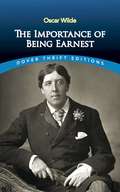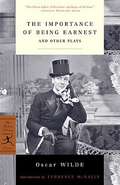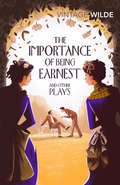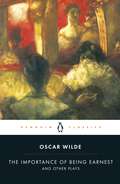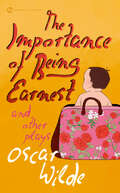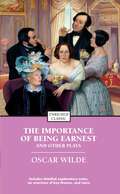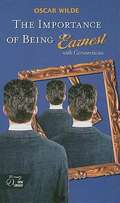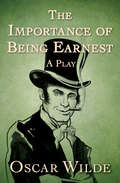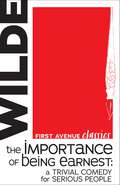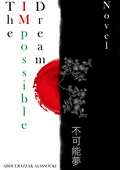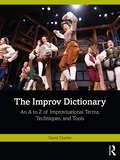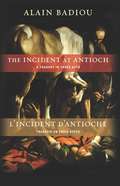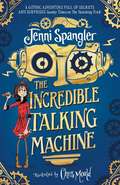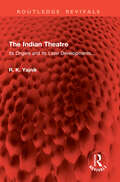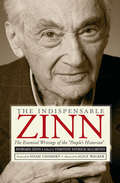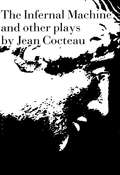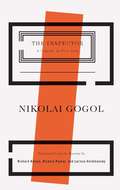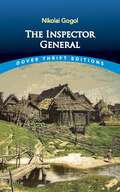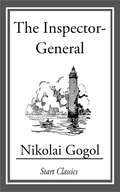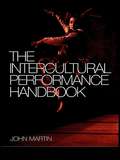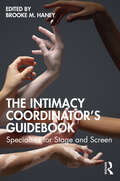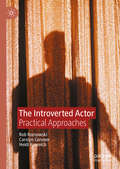- Table View
- List View
The Importance of Being Earnest (Dover Thrift Edition)
by Oscar WildeHere is Oscar Wilde's most brilliant tour de force, a witty and buoyant comedy of manners that has delighted millions in countless productions since its first performance in London's St. James' Theatre on February 14, 1895. The Importance of Being Earnest is celebrated not only for the lighthearted ingenuity of its plot, but for its inspired dialogue, rich with scintillating epigrams still savored by all who enjoy artful conversation.From the play's effervescent beginnings in Algernon Moncrieff's London flat to its hilarious denouement in the drawing room of Jack Worthing's country manor in Hertfordshire, this comic masterpiece keeps audiences breathlessly anticipating a new bon mot or a fresh twist of plot moment to moment.
The Importance of Being Earnest and Other Plays
by Oscar WildeOscar Wilde was already one of the best-known literary figures in Britain when he was persuaded to turn his extraordinary talents to the theatre. Between 1891 and 1895 he produced a sequence of distinctive plays which spearheaded the dramatic renaissance of the 1890s and retain their powertoday. This collection offers newly edited texts of Lady Windermere's Fan, A Woman of No Importance, Salome, An Ideal Husband, and, arguably the greatest farcical comedy in English, The Importance of Being Earnest. [This text is listed as an example that meets Common Core Standards in English language arts in grades 11-12 at http://www.corestandards.org.]
The Importance of Being Earnest and Other Plays
by Oscar WildeA selection of Oscar Wilde's best and most important plays - sharp, relevant and brilliant to this day. Who would have thought a comedy of manners written more than a hundred years ago would still be so apt and so funny? Oscar Wilde was a genius of play-writing, and his deftness, wit and sharp eye for social satire keep audiences in thrall to this day. Alongside Earnest, discover a biblical tragedy retold, Lady Windemere and her infamous fan and Wilde's take on an ideal husband, in this selection of Wilde's most important plays. ‘[The Importance of Being Earnest] has a strong claim to being the most perfect comedy in the English language’ Daily Telegraph
The Importance of Being Earnest and Other Plays
by Oscar WildeLady Windermere's Fan/Salomé/A Woman of No Importance/An Ideal Husband/A Florentine Tragedy/The Importance of Being Earnest'To lose one parent may be regarded as a misfortune; to lose both looks like carelessness'The Importance of Being Earnest is a glorious comedy of mistaken identity, which ridicules codes of propriety and etiquette. Snobbery and hypocrisy are also laid bare in Lady Windermere's Fan, A Woman of No Importance and An Ideal Husband, while in Salomé and A Florentine Tragedy, Wilde uses historical settings to explore the complex relationship between sex and power. The range of these plays displays Wilde's delight in artifice, masks and disguises, and reveals the pretensions of the social world in which he himself played such a dazzling and precarious part.Edited with Introduction, Commentaries and Notes by Richard Allen Cave
The Importance of Being Earnest and Other Plays
by Oscar WildeA universal favorite, The Importance of Being Earnest displays Oscar Wilde&’s wit and theatrical genius at their brilliant best. Subtitled &“A Trivial Comedy for Serious People,&” this hilarious attack on Victorian manners and morals turns a pompous world on its head, lets duplicity lead to happiness, and makes riposte the highest form of art. Written, according to Wilde, &“by a butterfly for butterflies,&” it is a dazzling masterpiece of comic entertainment.Although it was originally written in four acts, The Importance of Being Earnest is usually performed in a three-act version. This authoritative edition features an appendix that restores valuable lines that appeared in the original.Also included in this special collection are Wilde&’s first comedy success, Lady Windermere&’s Fan, and his richly sensual melodrama, Salomé, which he called &“that terrible coloured little tragedy I once in some strange mood wrote&”—and which shocked and enraged the censors of his time.Includes an Introduction by Sylvan Barnetand an Afterword by Elise Bruhl and Michael Gamer
The Importance of Being Earnest and Other Plays: Salome; Lady Windermere's Fan (Enriched Classics)
by Oscar WildeEnriched Classics offer readers accessible editions of great works of literature enhanced by helpful notes and commentary. Each book includes educational tools alongside the text, enabling students and readers alike to gain a deeper and more developed understanding of the writer and their work. Wilde's classic comedy of manners, The Importance of Being Earnest, a satire of Victorian social hypocrisy and considered Wilde's greatest dramatic achievement, and his other popular plays-Lady Windermere's Fan, An Ideal Husband, and Salome-challenged contemporary notions of sex and sensibility, class and cultural identity. Enriched Classics enhance your engagement by introducing and explaining the historical and cultural significance of the work, the author's personal history, and what impact this book had on subsequent scholarship. Each book includes discussion questions that help clarify and reinforce major themes and reading recommendations for further research. Read with confidence.
The Importance of Being Earnest with Connections
by Oscar WildeHolt McDougal Library, High School with Connections
The Importance of Being Earnest: A Play
by Oscar WildeThe controversial comedic play from a master dramatist that shattered social conventions in England. Oscar Wilde&’s most brilliant tour de force, a witty and buoyant comedy of manners, has delighted millions with countless productions since its first performance at London&’s St. James&’ Theatre in 1895. The Importance of Being Earnest is celebrated not only for the lighthearted ingenuity of its plot, but also for its inspired dialogue, rich with scintillating epigrams still savored by all who enjoy artful conversation. From the play&’s effervescent beginnings in Algernon Moncrieff&’s London flat to its hilarious denouement in the drawing room of Jack Worthing&’s country manor in Hertfordshire, this comic masterpiece keeps audiences breathlessly anticipating new bons mots and fresh plot twists from moment to moment. This ebook has been professionally proofread to ensure accuracy and readability on all devices.
The Importance of Being Earnest: A Trivial Comedy for Serious People (First Avenue Classics ™)
by Oscar WildeJack Worthing gets antsy living at his country estate. As an excuse, he spins tales of his rowdy brother Earnest living in London. When Jack rushes to the city to confront his "brother," he's free to become Earnest and live a different lifestyle. In London, his best friend, Algernon, begins to suspect Earnest is leading a double life. Earnest confesses that his real name is Jack and admits the ruse has become tricky as two women have become enchanted with the idea of marrying Earnest. On a whim, Algernon also pretends to be Earnest and encounters the two women as they meet at the estate. With two Earnests who aren't really earnest and two women in love with little more than a name, this play is a classic comedy of errors. This is an unabridged version of Oscar Wilde's English play, first published in 1899.
The Impossible Dream: The Cracked Necklace
by Halima Ezzahra ElbakouchiIn winter, in the beginning of an heavy snow, when a thick curtain appeared on the glass to prevent seeing; by lynching lamps from houses’ roof. A ten years kid started screaming “Mom, mom, …… mom”. It was a gloomy funeral, as the death of the mother Tekyami Kiya. The presence was so dejected, the father Tekyami Tadashi, Tekyami Dean the brother and some other family. As the ceremony finished, the family went back home, Akio went to his bed, putting his head under the pillows and started crying, repeating the memories of his mom that never go. Memories that never started yet, he quickly fell asleep. He was tired ... exhausted ... and alone... The memory of the date “the sixth of February” the snowfall time and the spread of frosts, the memory of the death of the mother, who will be absent, left a sad small family. She had been sick for years, and the doctors were confused about her poor health, but they indicated that it was related to her emotional state. After his sleeping, Akio’s dream started to live with him.
The Improv Dictionary: An A to Z of Improvisational Terms, Techniques, and Tools
by David CharlesThe Improv Dictionary: An A to Z of Improvisational Terms, Techniques, and Tools explores improvisational approaches and concepts drawn from a multitude of movements and schools of thought to enhance spontaneous and collaborative creativity.This accessible resource reveals and interrogates the inherited wisdoms contained in the very words we use to describe modern improv. Each detailed definition goes beyond the obvious clichés and seeks a nuanced and inclusive understanding of how art of the moment can be much more than easy laughs and cheap gags (even when it is being delightfully irreverent and wildly funny). This encyclopedic work pulls from a wide array of practitioners and practices, finding tensions and commonalities from styles as diverse as Theatresports, Comedysportz, the Harold, narrative long-form, Playback Theatre, and Boal’s Theatre of the Oppressed. Entries include nuanced definitions, helpful examples, detailed explorations of the concepts in practice, and framing quotes from a leading practitioner or inspirational artistic voice.The Improv Dictionary offers valuable insights to novice improvisers taking their first steps in the craft, seasoned performers seeking to unlock the next level of abandon, instructors craving a new comprehensive resource, and scholars working in one of the numerous allied fields that find enrichment through collaborative and guided play.Each significant entry in the book is also keyed to an accompanying improv game or exercise housed at www.improvdr.com, enabling readers to dig deeper into their process.
The Incident at Antioch / L’Incident d’Antioche: A Tragedy in Three Acts / Tragédie en trois actes (Insurrections: Critical Studies in Religion, Politics, and Culture)
by Alain BadiouThe Incident at Antioch is a key play marking Alain Badiou's transition from classical Marxism to a "politics of subtraction" far removed from party and state. Written with striking eloquence and extraordinary poetic richness, and shifting from highly serious emotional and intellectual drama to surreal comic interlude, the work features statesmen, workers, and revolutionaries struggling to reconcile the nature and practice of politics.This bilingual edition presents L'Incident d'Antioche in its original French and, on facing pages, an expertly executed English translation. Badiou adds a special preface, and an introduction by the scholar Kenneth Reinhard connects the play to Paul Claudel's The City, Saint Paul and the early history of the Church, and the innovative mathematical thinking of Paul Cohen. The translation includes Susan Spitzer's extensive notes clarifying allusions and quotations and hinting at Badiou's intentions. An interview with Badiou encompasses the play's settings, themes, and events, as well as his ongoing literary and conceptual experimentation on stage and off.
The Incident at Antioch/L'Incident d'Antioche
by Alain BadiouThe Incident at Antioch is a key play marking Alain Badiou's transition from classical Marxism to a "politics of subtraction" far removed from party and state. Written with striking eloquence and extraordinary poetic richness, and shifting from highly serious emotional and intellectual drama to surreal comic interlude, the work features statesmen, workers, and revolutionaries struggling to reconcile the nature and practice of politics. This bilingual edition presents L'Incident d'Antioche in its original French and, on facing pages, an expertly executed English translation. Badiou adds a special preface, and an introduction by the scholar Kenneth Reinhard connects the play to Paul Claudel's The City, Saint Paul and the early history of the Church, and the innovative mathematical thinking of Paul Cohen. The translation includes Susan Spitzer's extensive notes clarifying allusions and quotations and hinting at Badiou's intentions. An interview with Badiou encompasses the play's settings, themes, and events, as well as his ongoing literary and conceptual experimentation on stage and off.
The Incredible Talking Machine
by Jenni SpanglerPull back the curtain and enter a world where mystery and magic take centre stage . . . Twelve-year-old Tig works at the Theatre Royale, cleaning, selling tickets and doing anything else that is asked of her by her tyrannical boss, Mr Snell. But Tig will do whatever it takes to get closer to her dream – to become a Stage Manager and spend her days inventing new ways to imagine and build the intricate machinery and props that bring the exciting productions to life! But when a strange new act – a talking machine – arrives at the Theatre Royale, it moves and behaves in a way that Tig just can&’t work out. It&’s as though it&’s alive somehow . . . And when the machine appears to be hiding a dangerous secret, Tig must race against time to solve the mystery, before everything and everyone she cares about is lost forever. A gloriously gothic adventure from an original new voice in middle-grade. A gloriously gothic adventure with a magical twist from an original new voice in middle-grade. Perfect for fans of Michelle Harrison, Sophie Anderson and Emma Carroll. Praise for Jenni Spangler&’s debut novel, THE VANISHING TRICK: A thrilling, original, evocative and eerie tale - I adored it!&’ Michelle Harrison, author of A Pinch of Magic 'A thrilling page-turner. Madame Pinchbeck is a gloriously Dickensian villain&’ Abi Elphinstone, author of Sky Song 'Ghosts, gadgets, likeable villains and unlikely heroes: The Vanishing Trick is a dark and dazzling adventure&’ Emma Carroll, author of Letters from the Lighthouse 'A completely enthralling tale, oozing with atmosphere and originality&’ Catherine Doyle, author of The Storm Keeper's Island
The Indian Theatre: Its Origins and Its Later Developments... (Routledge Revivals)
by R. K. YajnikFirst published in 1933, The Indian Theatre provides a comprehensive overview of the origin and the later developments of theatre in India under European influence with special reference to Western India. It discusses important themes such as the early Indian stage; the ancient Hindu stage; the rise of modern theatres; stage-versions of Shakespearean comedies; stage-versions of Shakespearean tragedies; influence of non-Shakespearean plays and the general influence of British drama.The first four chapters provides the religious basis of the Sanskrit drama, it's essentially idealistic, poetic and romantic atmosphere along with its characteristic contribution of the rasa theory. The second part of the book discusses the rise of the European theatres, mostly amateur in character, in the three great cities of India- Calcutta, Bombay and Madras. This is an important historical reference work for students and scholars of Indian theatre, theatre history, and theatre and performance studies.
The Indispensable Zinn: The Essential Writings of the "People's Historian"
by Howard ZinnA &“well-chosen anthology of the radical historian&’s prodigious output,&” from A People&’s History of the United States and lesser known sources (Kirkus Reviews). When Howard Zinn died in early 2010, millions of Americans mourned the loss of one of the nation&’s foremost intellectual and political guides; a historian, activist, and truth-teller who, in the words of the New York Times&’s Bob Herbert, &“peel[ed] back the rosy veneer of much of American history to reveal sordid realities that had remained hidden for too long.&” A collection designed to highlight Zinn&’s essential writings, The Indispensable Zinn includes excerpts from Zinn&’s bestselling A People&’s History of the United States; his memoir, You Can&’t Be Neutral on a Moving Train; his inspiring writings on the civil rights movement, and the full text of his celebrated play, Marx in Soho. Noted historian and activist Timothy Patrick McCarthy provides essential historical and biographical context for each selection. With a foreword by Noam Chomsky and an afterword from Zinn&’s former Spellman College student and longtime friend, Alice Walker, The Indispensable Zinn is both a fitting tribute to the legacy of a man whose &“work changed the way millions of people saw the past,&” and a powerful and accessible introduction for anyone coming to Zinn&’s essential body of work for the first time (Noam Chomsky).
The Infernal Machine & Other Plays
by Jean CocteauFour full-length plays by one of the greatest dramatists Europe has produced. Among the great figures who pioneered the modern movement in world literature, none showed himself more versatile than France's Jean Cocteau. Poet, novelist, critic, artist, actor, film-maker, Cocteau was also one of the greatest dramatists Europe has produced, with over a dozen plays which are frequently revived, not only in France, but in translation in many other countries. For this collection, fine translations of four full-length plays, one short play, and the "Speaker's Text" for the Cocteau-Stravinsky opera Oedipus Rex have been selected. The longer plays (The Infernal Machine, Orpheus, Bacchus, Knights of the Round Table) are re-creations of classic myth and legend--poetic and highly original interpretations of certain timeless themes which have inspired great drama through the ages. The Eiffel Tower Wedding Party is, by contrast, merely a "curtain-raiser," but remarkable as un jeu d'esprit, revealing the wit and psychological penetration for which Cocteau is famous.
The Inspector
by Nikolai Gogol Larissa Volokhonsky Richard Pevear Richard NelsonA revelatory new translation of Gogol's comedy by renowned playwright Richard Nelson and Richard Pevear & Larissa Volokhonsky - the foremost contemporary translators of classic Russian literature including the best-selling Oprah's Book Club selection, Anna Karenina - marks the first of a series of translations of important Russian plays over the next ten years.
The Inspector General (Dover Thrift Editions: Plays)
by Nikolai GogolConsidered the high point of Gogol's writing for the stage and a masterpiece of dramatic satire, The Inspector General skewers the stupidity, greed, and venality of Russian provincial officials. When it is announced that the Inspector General is coming to visit incognito, Anton, the chief of police, hastens to clean up the town before his arrival. Local officials scurry to hide evidence of bribe-taking and other misdeeds, setting the stage for the arrival from St. Petersburg of Ivan, a penurious gambler and rake who is promptly taken by the townspeople to be the dreaded Inspector General. Ivan, and his servant, Osip, soon take advantage of the situation with hilarious results. First performed in 1836, the play transcends regional and national boundaries to offer a biting, highly entertaining glimpse of universal human foibles and failings.
The Inspector-General
by Nikolai GogolWhen rumors of a visit from a high-ranking bureaucrat reach a small town, the chief of police scrambles to conceal the evidence of bribery and other misdeeds. Considered the high point of Gogol's stagecraft and a masterpiece of dramatic satire, this play lampoons the stupidity and greed of provincial Russian officials.
The Intercultural Performance Handbook
by John MartinThe Intercultural Performance Handbook opens up a new world of technique for performers. The first ever full-length, fully illustrated manual for practitioners, it provides:*a guide to the physical, vocal and improvisational dynamics drawn from world performance styles*a new vocabulary with which to interpret plays from around the globe*games to use for exploring rhythm, movement, balance, tension and gesture, breathwork, stylisation and the use of the voice*a practical approach to creating vibrant theatrical work.Studies on intercultural performance are usually written by scholars and reasearchers. John Martin explains the definition and development of intercultural performance studies from the perspective of an experienced practitioner. He provides exercises, practical advice and a clear training process for the inquiring actor or director.This book is a process of discovery, carefully written so as to develop understanding and move towards empowerment for the adventurous theatre-maker.
The Intimacy Coordinator's Guidebook: Specialties for Stage and Screen
by Brooke M. HaneyThe Intimacy Coordinator's Guidebook: Specialties for Stage and Screen explores the role of the intimacy choreographer with an in-depth look at specializations that exist within the profession.With contributions by over 30 industry professionals, this book aims to bring awareness to a wide range of needs a project may have and how intimacy professionals use their cultural competency specialists in practice to create the most compelling storytelling. In Part One, the book addresses the scope of practice of an intimacy professional by discussing competency, finding your lens and tangential fields in the industry like fight directors, mental health coordinators and cultural competency specialists. Part Two covers specialties like working with minors, prosthetics, intimacy and disability, staging queer intimacy, working with fat actors, Black American intimacy, dance, working on scenes of trauma, sexual violence and non-consent, and BDSM. Between each chapter is a conversation with an actor, director or producer on their experiences working with an intimacy coordinator. In Part Three, the book looks at what it means to be qualified and intimacy professionals' hopes for the future of the industry.The Intimacy Coordinator's Guidebook is an invaluable resource for directors and producers looking to hire an intimacy professional, as well as in-depth study for those who are training or practicing in the field of intimacy for performance.
The Introverted Actor: Practical Approaches
by Rob Roznowski Carolyn Conover Heidi KasevichDo you have to be an extrovert to succeed as an actor? This book offers ideas to create inclusive acting environments where the strengths of the introverted actor are as valued as those of their extroverted counterparts. As this book shows, many introverts are innately drawn to the field of acting, but can often feel inferior to their extroverted peers. From the classroom to professional auditions, from rehearsals to networking events, introverted actors tell their stories to help other actors better understand how to leverage their natural gifts, both onstage and off. In addition, The Introverted Actor helps to reimagine professional and pedagogical approaches for both actor educators and directors by offering actionable advice from seasoned psychology experts, professional actors, and award-winning educators.
